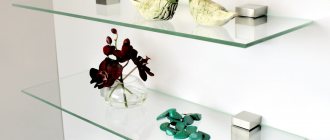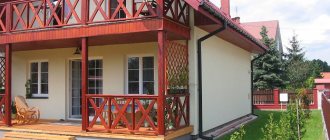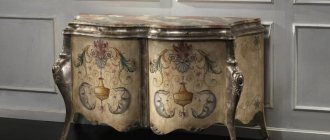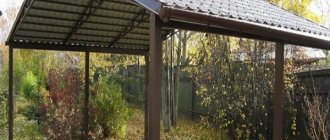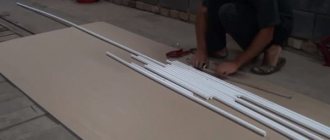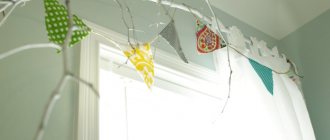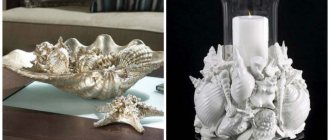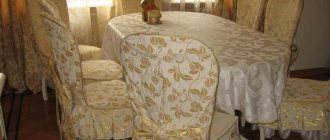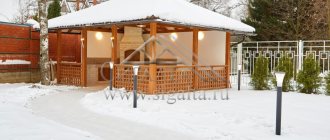Often in many apartments you can see numerous shelves on the balcony. This is where it is customary to store everything that does not fit in the closets. If you approach this issue wisely and with imagination, then on the balcony you can not only save things, but also spend time with benefit and pleasure. To do this, you need to think about how to intelligently organize storage.
You will learn how to make shelves on the balcony and which ones to choose after reading this short article. They are classified according to various criteria. It is important at the planning stage to clearly determine what type of shelves on the balcony will be comfortable and durable. Let's look at different classifications of species diversity.
Classification of shelves by mounting method
Based on the method of fastening, balcony shelves are divided into removable and folding, fixed, and also suspended and floor-mounted. Removable shelves are made from materials such as metal, solid wood or durable glass because they must withstand frequent re-hanging. Folding ones are convenient when the need for them is intermittent. If necessary, they can be easily reclined and folded when not needed. With this type it is possible to increase space.
Fixed shelves provide safe storage of heavy items. Hanging ones will be the best solution for small balconies, since this type takes up very little space. Floor shelves have proven themselves well on narrow, elongated loggias.
Classification by shape
According to their shape, balcony shelves are divided into straight, angular and curly, open and closed, and also into mirrored, illuminated and combined. Straight shelves look very simple: they have neither figured nor artistic elements. Corner ones are considered very compact and convenient, because they can significantly save space in a small area. They are attached with brackets to two adjacent walls. Curly shelves, as opposed to straight ones, look very interesting and unique. Open shelves are installed on the balcony to store interesting decorative compositions. The closed type is used to store unaesthetic items, as well as those that are not needed for frequent use.
Shelves with mirrors visually increase the space of the balcony, even if it is small in size. Illuminated shelves are an additional source of lighting on the balcony. This is especially true for balconies located most of the time in the shade. Combined ones are the preferred choice for a balcony, because shelves of various types can be combined here, which meets not only the criteria of spaciousness and convenience, but also aesthetics.
Metal rack
In some cases, constructing a structure made of metal will be preferable, because it can withstand increased loads. At the same time, the main enemy of metal is moisture, so protective coatings are required to prevent corrosion. Metal racks used on the balcony are not afraid of temperature changes, but must be protected from moisture.
Installation of a metal rack has some features:
- Small diameter pipes and a metal corner can be used for the frame. You can use any materials to lay the shelves, as long as they can withstand the planned weight.
- Fastening is carried out using bolts or metal screws. You can weld the joints, but in this case welding equipment is required, and it may be difficult to place the finished product in the limited space of the balcony. It is more expedient to carry out the assembly directly in the room, or to use large elements that are joined in place.
- All metal surfaces must be painted before assembly, and when finished, they must be touched up in areas of damage.
- There are ready-made sections made from metal corners and sheets for shelves. Such designs can be ordered according to individual sizes, made angular (in the form of the letters “G” or “P”). They are also easy to assemble and visually appealing. The only drawback will be the high cost, while a self-made product gives you a chance to save a lot of money.
The option of a combined product is no less popular. Most often we are talking about a metal frame with installed wooden shelves. This design is designed for significant weight, is durable and does not require significant financial investments, because the remains of old furniture, as well as materials unused during the construction process, will be used.
Types of balcony shelves by purpose
Conventionally, balcony shelves are divided according to their purpose into book shelves, shoe shelves, souvenir shelves, universal shelves, as well as shelves for indoor plants, storing jars or tools. It’s not hard to guess that bookshelves are used to store books, and shoe shelves are used to store out-of-season shoes. Souvenirs serve only for artistic decoration of the balcony.
Universal ones, on the contrary, are relevant for those who do not think about aesthetics. Shelves for indoor plants on the balcony are indispensable for those who grow flowers. It’s much more pleasant to be on such a balcony. Shelves for storing jars will be a salvation for summer residents and lovers of conservation. Before making a similar structure on the balcony, it is important to take into account the weight of the intended luggage. Shelves for storing tools will delight men with their functionality.
Classification by materials of manufacture
These products can be made of wood, metal, plastic, glass or several materials at the same time. Shelves on a wooden balcony always look expensive and beautiful, but for durability they must be coated with special protective varnishes that prevent moisture from penetrating into the material.
Metal shelves are considered the most practical, durable and strong. Plastic products look very attractive, and they are highly resistant to wear. Glass shelves will not only help create a feeling of lightness, but their texture is very durable. Their only drawback is the difficulty of installation. Products made from combined materials combine several types of them, for example, the shelf itself can be made of plastic and the doors made of glass. When choosing materials for manufacturing, it is necessary to evaluate the size and presence of glazing, as well as the purpose of the balcony shelves themselves.
Main product options
Taking into account the fact that the conditions on the balcony are very aggressive, that is why it is so important to select high-quality components. Products must withstand sudden temperature changes, different humidity levels, gas pollution, and UV radiation. It is recommended to abandon particle board and use laminated sheets. Its protective layer will prevent excess moisture from entering, which will preserve the parameters of the product.
Laminated chipboard has excellent external components, durable protection and a large selection of colors. Therefore, this option does not have to be coated with paint and varnish products. You can also use natural materials - wood, plywood, but they just need to be coated with protective agents. This way you can protect natural material, which is also more expensive than others.
Shelves for the balcony should be combined. The frame is made of steel corners, the shelves themselves are made of wood, the walls are made of plywood, and the doors are made of glass. This combination allows you to create your ideal closet with the necessary shelves. If there is old furniture in the house, it can be disassembled and used as components of shelves.
READ MORE: Plastic cabinet for balcony
Choosing shelves for the balcony
Based on your needs, capabilities and fantasies, you can design a unique, inimitable product. Your shelf for a loggia or balcony can be simple or extremely original. The chosen type of installation work and the materials of the shelf determine its relevance and durability in the future.
Corner combination options are considered an excellent option for a small balcony. They are great space savers and make it possible to hide ugly things in closed drawers, and display indoor plants and other decorative elements in open ones.
DIY wooden shelves
If the rack is mounted in the depths of a loggia or balcony, that is, it will be surrounded by walls on three sides, then the simplest option is to fasten wooden boards, fiberboard, chipboard or other sheet material to metal corners nailed to the wall (photo 1). Instead of corners, you can also use wooden blocks, which before installation are carefully sanded and coated with paint or varnish in several layers.
A more reliable design is a wooden frame-type rack, on which it will be possible to store large and heavy objects (canned goods, tool boxes, microwave ovens, etc.).
Wooden flower rack
Before you make a wooden rack with your own hands, you need to prepare the following tools and materials:
- grinder or hand saw for wood;
- electric drill;
- building level;
- roulette;
- hammer;
- wooden beams with a cross-section of at least 50×50 mm;
- cladding material;
- material for making shelves;
- fasteners.
First, to visualize the upcoming work, a drawing of the future product is made on a sheet of paper and markings are made (photo 2). Next, prepared beams are screwed to the floor, ceiling and walls using dowels, which will serve as the frame of the rack.
To avoid distortions, the verticality and horizontality of all elements must be constantly monitored with a building level.
Next, the back wall of the frame is covered with plywood, and the side walls with chipboard or fiberboard. To install shelves in the required places, metal corners are attached to the side walls at the rate of 4-6 fasteners per element (photo 3). At the last stage, the wooden shelves are mounted in place and fixed to the corners with screws. If you want to make a closed shelving unit, you can install single or double leaf doors on the frame.
Blueprints
Before drawing a drawing, drawing up a project and calculating the amount of material needed, it is important to determine the purpose of the shelves and cabinets. You can easily make a balcony shelf with your own hands or rely on specialists. Masters of their craft will help you make a choice, draw up a layout and design the product of your dreams. However, if you add a little skill and calculations, your homemade shelf will be indistinguishable from a professional one.
How to make a shelf on the balcony?
There are many options for installation, but each of them has its own, different method of fastening. Before starting, it is important to think in detail about the shape of the product and determine its purpose.
In order to be able to store heavy objects, you need a mount that can withstand the expected weight. Such shelves must be secured with anchor bolts and metal frame corners.
Products of small sizes should be secured to hinges that are attached to the walls of the balcony with dowels or self-tapping screws. To make shelves on a balcony with your own hands, you need to have the necessary tools and strictly follow the algorithm for performing installation work.
Do you need shelves or a closet on the loggia?
Balcony shelving has become extremely popular recently. Almost all of our apartments are equipped with a balcony or loggia. Traditionally, this is where currently unnecessary things, household supplies, tools and much more are stored. Without a certain system of organizing, all things sooner or later turn into unaesthetic and inconvenient trash that takes up your living space.
Shelves with flower pots will allow your loggia to become a cozy oasis, a kind of winter garden, where it is so nice to have a cup of tea in the evening.
But with very little effort, you can make loggias not just functional, but also attractive rooms, the real pride of the apartment.
Shelves and a closet will come to the rescue in this matter. They are the ones who will help organize the space as efficiently as possible, allocating each item its own specific place.
A cabinet on the loggia is an ideal place to store canned goods, tools, books or rarely used equipment. And shelves with placed flower pots will allow your loggia to become a cozy oasis, a kind of winter garden, where it is so nice to have a cup of tea in the evening. Both the closet and the shelves do not take up much space, so you should not be afraid to significantly reduce the area of the loggia. On the contrary, suspended structures allow you to use space as ergonomically and efficiently as possible, visually expand or lengthen it.
Racks must meet the following requirements: •high strength; •moisture resistance; •safety; •optimal placement.
Balcony racks, no matter whether you are planning shelves for flowers or a full-fledged closet, must meet the following requirements:
- high strength;
- moisture resistance (insufficient protection of window frames or intensive watering of flowers can lead to damage; wooden structures are especially at risk);
- safety (all structures on the loggia, no matter whether they are made by a craftsman or with your own hands, must be securely fastened);
- optimal placement (loggias initially do not have large spaces, therefore, when constructing metal or wooden structures with your own hands, it makes no sense to make them bulky and preventing the penetration of light into the room).
Related article: Accessories and decorative items made of wire in the interior (51 photos)
Carrying out work
Before starting installation, you must prepare the following tools:
- perforator;
- screwdriver;
- jigsaw;
- drill;
- level;
- nuts;
- spanners.
Algorithm for installing suspended balcony shelves:
- Take a sheet of plywood (fibreboard) and cut out a slab of the intended size. The structure will become more stable if metal pipes are attached to the ends of the shelf.
- Mark holes at a distance of 6-8 cm from the edge of the shelf into which the pins will later be inserted.
- Drill the marked holes. Use a pencil or pen to transfer the location of the holes, placing the shelf against the ceiling. This way you can avoid the oblique position of the product.
- Drill holes in the ceiling, first removing dust from them. Insert the anchor into the ceiling until it stops, tighten it with nuts.
- Connect the studs to the anchors placed on the ceiling.
- Secure the structure using coupling nuts. Screw the nut onto the stud and then the washer.
- Thread the shelf directly onto the ends of the studs, securing with a Grover washer and a control nut. Adjust the fittings fasteners to the required level.
